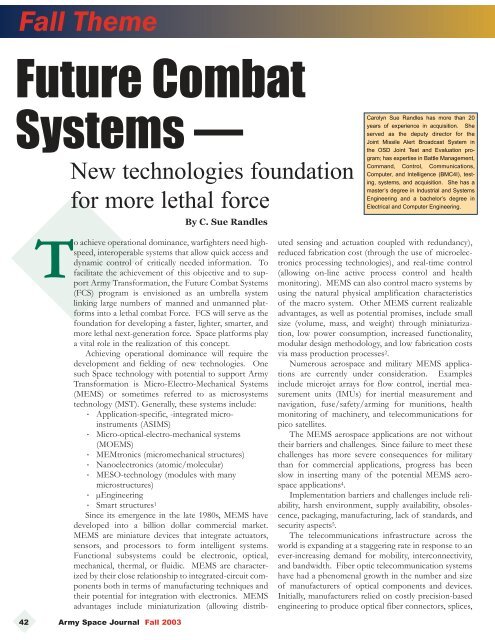Volume 2, Number 4 - Space and Missile Defense Command - U.S. ...
Volume 2, Number 4 - Space and Missile Defense Command - U.S. ...
Volume 2, Number 4 - Space and Missile Defense Command - U.S. ...
Create successful ePaper yourself
Turn your PDF publications into a flip-book with our unique Google optimized e-Paper software.
Fall Theme<br />
Future Combat<br />
Systems —<br />
New technologies foundation<br />
for more lethal force<br />
Carolyn Sue R<strong>and</strong>les has more than 20<br />
years of experience in acquisition. She<br />
served as the deputy director for the<br />
Joint <strong>Missile</strong> Alert Broadcast System in<br />
the OSD Joint Test <strong>and</strong> Evaluation program;<br />
has expertise in Battle Management,<br />
Comm<strong>and</strong>, Control, Communications,<br />
Computer, <strong>and</strong> Intelligence (BMC4I), testing,<br />
systems, <strong>and</strong> acquisition. She has a<br />
master’s degree in Industrial <strong>and</strong> Systems<br />
Engineering <strong>and</strong> a bachelor’s degree in<br />
Electrical <strong>and</strong> Computer Engineering.<br />
By C. Sue R<strong>and</strong>les<br />
To achieve operational dominance, warfighters need highspeed,<br />
interoperable systems that allow quick access <strong>and</strong><br />
dynamic control of critically needed information. To<br />
facilitate the achievement of this objective <strong>and</strong> to support<br />
Army Transformation, the Future Combat Systems<br />
(FCS) program is envisioned as an umbrella system<br />
linking large numbers of manned <strong>and</strong> unmanned platforms<br />
into a lethal combat Force. FCS will serve as the<br />
foundation for developing a faster, lighter, smarter, <strong>and</strong><br />
more lethal next-generation force. <strong>Space</strong> platforms play<br />
a vital role in the realization of this concept.<br />
Achieving operational dominance will require the<br />
development <strong>and</strong> fielding of new technologies. One<br />
such <strong>Space</strong> technology with potential to support Army<br />
Transformation is Micro-Electro-Mechanical Systems<br />
(MEMS) or sometimes referred to as microsystems<br />
technology (MST). Generally, these systems include:<br />
· Application-specific, -integrated microinstruments<br />
(ASIMS)<br />
· Micro-optical-electro-mechanical systems<br />
(MOEMS)<br />
· MEMtronics (micromechanical structures)<br />
· Nanoelectronics (atomic/molecular)<br />
· MESO-technology (modules with many<br />
microstructures)<br />
· μEngineering<br />
· Smart structures 1<br />
Since its emergence in the late 1980s, MEMS have<br />
developed into a billion dollar commercial market.<br />
MEMS are miniature devices that integrate actuators,<br />
sensors, <strong>and</strong> processors to form intelligent systems.<br />
Functional subsystems could be electronic, optical,<br />
mechanical, thermal, or fluidic. MEMS are characterized<br />
by their close relationship to integrated-circuit components<br />
both in terms of manufacturing techniques <strong>and</strong><br />
their potential for integration with electronics. MEMS<br />
advantages include miniaturization (allowing distributed<br />
sensing <strong>and</strong> actuation coupled with redundancy),<br />
reduced fabrication cost (through the use of microelectronics<br />
processing technologies), <strong>and</strong> real-time control<br />
(allowing on-line active process control <strong>and</strong> health<br />
monitoring). MEMS can also control macro systems by<br />
using the natural physical amplification characteristics<br />
of the macro system. Other MEMS current realizable<br />
advantages, as well as potential promises, include small<br />
size (volume, mass, <strong>and</strong> weight) through miniaturization,<br />
low power consumption, increased functionality,<br />
modular design methodology, <strong>and</strong> low fabrication costs<br />
via mass production processes 2 .<br />
Numerous aerospace <strong>and</strong> military MEMS applications<br />
are currently under consideration. Examples<br />
include microjet arrays for flow control, inertial measurement<br />
units (IMUs) for inertial measurement <strong>and</strong><br />
navigation, fuse/safety/arming for munitions, health<br />
monitoring of machinery, <strong>and</strong> telecommunications for<br />
pico satellites.<br />
The MEMS aerospace applications are not without<br />
their barriers <strong>and</strong> challenges. Since failure to meet these<br />
challenges has more severe consequences for military<br />
than for commercial applications, progress has been<br />
slow in inserting many of the potential MEMS aerospace<br />
applications 4 .<br />
Implementation barriers <strong>and</strong> challenges include reliability,<br />
harsh environment, supply availability, obsolescence,<br />
packaging, manufacturing, lack of st<strong>and</strong>ards, <strong>and</strong><br />
security aspects 5 .<br />
The telecommunications infrastructure across the<br />
world is exp<strong>and</strong>ing at a staggering rate in response to an<br />
ever-increasing dem<strong>and</strong> for mobility, interconnectivity,<br />
<strong>and</strong> b<strong>and</strong>width. Fiber optic telecommunication systems<br />
have had a phenomenal growth in the number <strong>and</strong> size<br />
of manufacturers of optical components <strong>and</strong> devices.<br />
Initially, manufacturers relied on costly precision-based<br />
engineering to produce optical fiber connectors, splices,<br />
42<br />
Army <strong>Space</strong> Journal Fall 2003

















